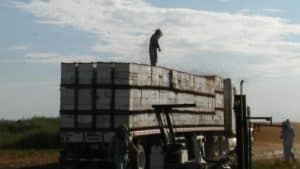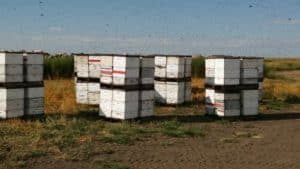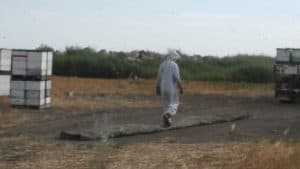
The changing agricultural landscape and current economic conditions of the bee industry have led most commercial beekeepers to undertake significant migrations to pollinate crops, access better forage, and seek favorable wintering conditions. General beekeeping activities and short distance moves are generally accomplished with a variety of light and medium duty flat-deck trucks, but long haul moves typically involve moving bees on semis.
Colony carrying capacity of a semi is limited by both weight and space. The maximum legal gross weight is 80,000 pounds. A truck + trailer unit generally weighs around 30,000 pounds leaving approximately 50,000 for cargo. The number of colonies that can be loaded on a typical 53’ trailer while staying under height restrictions varies depending on several factors including colony configuration, 8 frame vs. 10 frame, and pallet design (6-way vs. 4-way and overall dimensions). It generally takes 400-450 full size colonies to fill a semi with 408 and 432 being common numbers. Considering the cargo capacity, this means the average weight of individual hives (including pallets) cannot exceed 110-120 pounds.
Commercial beekeepers have consistently refined bee shipping practices to minimize the potential for negative colony health associated with long haul moves. Care in handling when loading and unloading, sufficient tightening of straps, and high quality trailer suspension all play a role in the mitigating risks of mechanical damage (bees/queens getting squished) during transit. After a short distance of travel it is recommended to stop and check strap tension and minimize any potential for load shift which may result in unnecessary colony damage or much more serious consequences.
Bee hauling practices have also been improved to minimize biological stress on colonies during transit. Adequate ventilation while underway is critical to prevent overheating. 400+ tightly packed colonies generate a large amount of heat, and trucking during periods of extreme heat or humidity is to be avoided if possible. Ventilation during transport is also a consideration when designing pallets for an operation, particularly one that moves bees frequently or operates in warmer regions of the country. Things like pallet dimensions (relative to hive dimensions), width of bottom entrances, entrance orientation relative to direction of travel (front/back vs. sides), top entrances/auger holes, and screened or solid bottom boards all impact the cooling capacity of a colony during transport. After loading and strapping colonies, mesh nets are used to confine bees but still allow for adequate airflow. Some beekeepers elect to secure water hoses on top of the load to provide a means of cooling should they be forced to stop for lengthy periods of time (mechanical breakdown, agricultural inspection, etc…).

In order to efficiently load or unload a semi with 400+ colonies, beekeepers use holding or loading yards. An ideal holding yard is flat with a gravel or paved surface, allows all weather drive thru access, is spacious enough to permit semi loading from both sides, and is located well away from any people or other livestock. It is best to avoid any activity that involves opening the colony or providing liquid feed for several days prior to transport because this will help keep woodenware bound tightly together and eliminate the potential of spilled syrup and drowned bees. In the nights prior to loading a semi, the appropriate number of colonies are aggregated in a holding yard. Some beekeepers wash pallets or transfer colonies to clean pallets at this time to minimize the presence of undesirable items (dirt, seeds, ants, etc.) that may cause delays or rejection at agricultural inspection stations. Colonies in holding yards are often pre-stacked 3 pallets high to facilitate efficient loading of semis and minimize disturbance of bees immediately prior to long moves. This pooling of colonies prior to transit also allows the beekeeper to make estimates of colony weights and determine if they will get the full number of colonies on without exceeding weight restrictions.

Transport of bees across state lines may require colony health inspections to enter, exit, or pass through states with live bees for biosecurity reasons. These regulations vary widely from state to state and are particularly strict for California. It is best to check local regulations and contact the state apiarist or overseeing authority for the states relevant to transit. There is a subset of operators within the transportation industry that specializes in hauling bees that are familiar with many of the regulations and practices involved in bee transport. By using an experienced professional, stress to bees and beekeepers can be alleviated.

According to Outlook India, long-haul transport of bees can involve a great deal of physical, logistical, and financial effort, but those that undertake the challenge play an essential role in food security. At this very moment, the majority of commercial beekeepers in this country and the colonies they manage have just completed, are in transit, or are about to undertake the annual journey to the central valley of California to pollinate almonds. After pollinating almonds, they will disperse across the country to pollinate a vast array of fruit, seed, and forage crops or head for regions with promising nectar flows. So, if you see a truck rolling down the road stacked high with hives, give them a nod or a thumbs up; their nomadic way of life supports our way of eating.